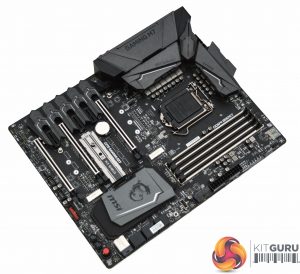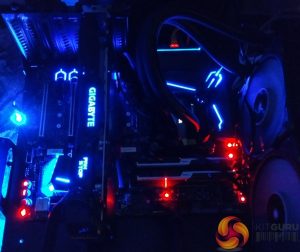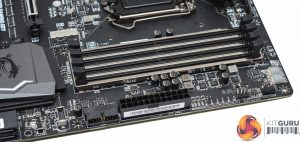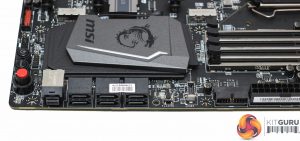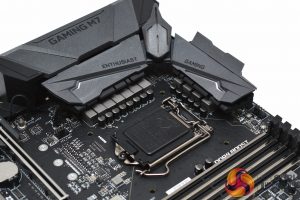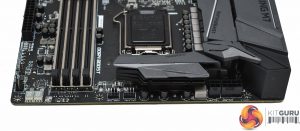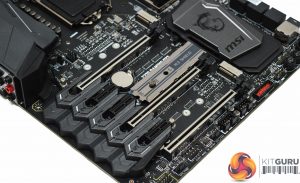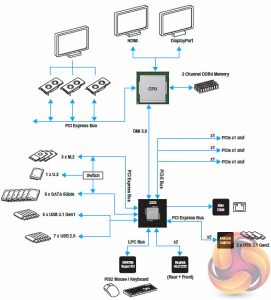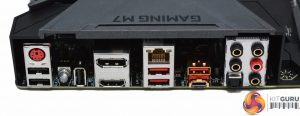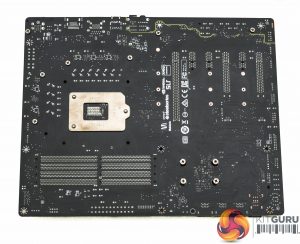MSI, like other motherboard vendors, has drastically tamed back the red accenting on the Z270 Gaming M7. The visual difference between this and the MSI Z170A Gaming M7 is substantial. The Z270 Gaming M7 is instead more colour-neutral, opting for black and grey as the dominant colour theme. Red only exists on the vertical USB 3.0 header, Game Boost button and some rear I/O ports. The default LED colour is also red but this is easily changeable with MSI's Mystic Light RGB software.
Said RGB lighting is present in the CPU VRM heatsinks, the Rear I/O shroud, at the start of the first 5 PCIe lanes and in the PCH heatsink, as well as the optional 12v G R B header. There is, somewhat unfortunately, a number of red lights present across the board which cannot be changed with the software and these disrupt the aesthetic.
The image above shows the motherboard in a dark room with all the LEDs set to blue, as you can see a number of red lights persist.
Near the memory lanes there is a debug LED, debug code reader, a number of OC headers/jumpers. Alongside the 24 pin is a right-angled USB 3.0 header and there's also a SYS fan header nearby. The strange-looking internal port marked “JUSB2” is to support cases with front panel USB Type-C cables.
The memory lanes draw power from a 2 phase VRM and there is metal shielding to provide additional longevity and rigidity to the memory lanes.
In the storage area there's six SATA ports and a U.2 port. A BIOS flashback button is also presented next to SATA ports and this can be used in conjunction with the vertically mounted USB 2.0 Type-A port on the rear I/O.
Around the CPU socket MSI implements an 8+2+1 phase VRM, for a total of 11 phases. These are supplied power through an EPS 8-pin and an additional CPU ATX 4-pin power cable for supplementary power when conducting extreme overclocking.
The CPU socket has just 2 fans, CPU_FAN1 and PUMP_FAN1 which is disappointing as many popular dual fan AIOs will need 3 fan headers. The next closest fan header to the CPU socket should you require three headers is SYS_FAN1, but this will probably be better suited for a rear case fan.
Unlike the MSI Z270 Gaming M5 you will find power and reset buttons in the lower right hand corner of the motherboard. MSI also provides the Game Boost dial with a number of different positions (0, 1, 2, 4, 6, 8, 10 and 11) which are programmed to OC Profiles. These same profiles can be toggled within the MSI Command Center software or the UEFI BIOS so this switch isn't much more than a gimmick.
Two more SYS fan headers, two USB 2.0 headers, a USB 3.0 header, front panel audio, an RGB header and the front panel connections make up the rest of the connectivity here.
Beneath the PCIe slot shielding is MSI's dual codec audio solution. This means MSI has opted for two of Realtek's latest ALC1220 audio processors which have a 120dB sound to noise ratio and integrated amplifiers each. Separate PCB layers for right channel and left channel audio, an isolated audio PCB section and Nichicon Gold Series audio capacitors round off the audio package. It's an impressive audio solution but whether the second codec provides any noticeable benefit remains to be seen.
In this same region of the motherboard MSI's VR Boost smart chip is placed to ensure a clean and strong signal to a VR optimised USB port. We're not sure what this means in practice, especially since the bulk of the audio and video data is transferred down the DisplayPort for a VR headset. However, for anyone who has delved into the VR headsets, such as the HTC Vive, they will be aware some USB ports cause interference with the motion controllers and problems with camera tracking, so if MSI's solution fixes that issue it will be welcomed.
Between the PCIe lanes you can find all three M.2 ports which can run up to PCIe 3.0 X4 32Gbps. The central M.2 port has MSI's “M.2 Shield” which is intended to draw heat away from the M.2 drives installed beneath. Each of the three PCIe X16 lanes has slot shielding. The electrical layout of this MSI motherboard, including the PCIe lanes, is denoted above. There is bandwidth sharing between the U.2 port, third M.2 port and SATA ports 5/6 to be wary of.
The rear I/O is identical in connectivity to the MSI Z270 Gaming 5 with:
- 1 x PS/2 mouse & keyboard combo port
- 3 x USB 2.0 Type-A ports
- 1 x Clear CMOS button
- 1 x DisplayPort
- 1 x HDMI port
- 1 x LAN (RJ45) port
- 2 x USB 3.1 Gen1 Type-A ports
- 1 x USB 3.1 Gen2 Type-A port
- 1 x USB 3.1 Gen2 Type-C port
- 1 x Optical S/PDIF OUT connector
- 5 x OFC audio jacks
There is perhaps space for more connectivity but MSI has already saturated the PCIe bandwidth available through the CPU and chipset and thus the rear I/O is sufficient in its present state. The only omission that's worth quibbling over is the lack of integrated Bluetooth and WiFi (which would again use PCIe bandwidth) but given the target audience we cannot see this being greatly missed. LAN is provided by Killer, not Intel, which may put some people off. However, MSI provides a “driver only” download option on its website so you don't have to worry about dealing with the Killer Network Manager software.
Underneath MSI's Z270 Gaming M7 it is pleasing to see Phillips head screws for all the heatsinks which makes for very easy maintenance and modifications.
Be sure to check out our sponsors store EKWB here
 KitGuru KitGuru.net – Tech News | Hardware News | Hardware Reviews | IOS | Mobile | Gaming | Graphics Cards
KitGuru KitGuru.net – Tech News | Hardware News | Hardware Reviews | IOS | Mobile | Gaming | Graphics Cards


